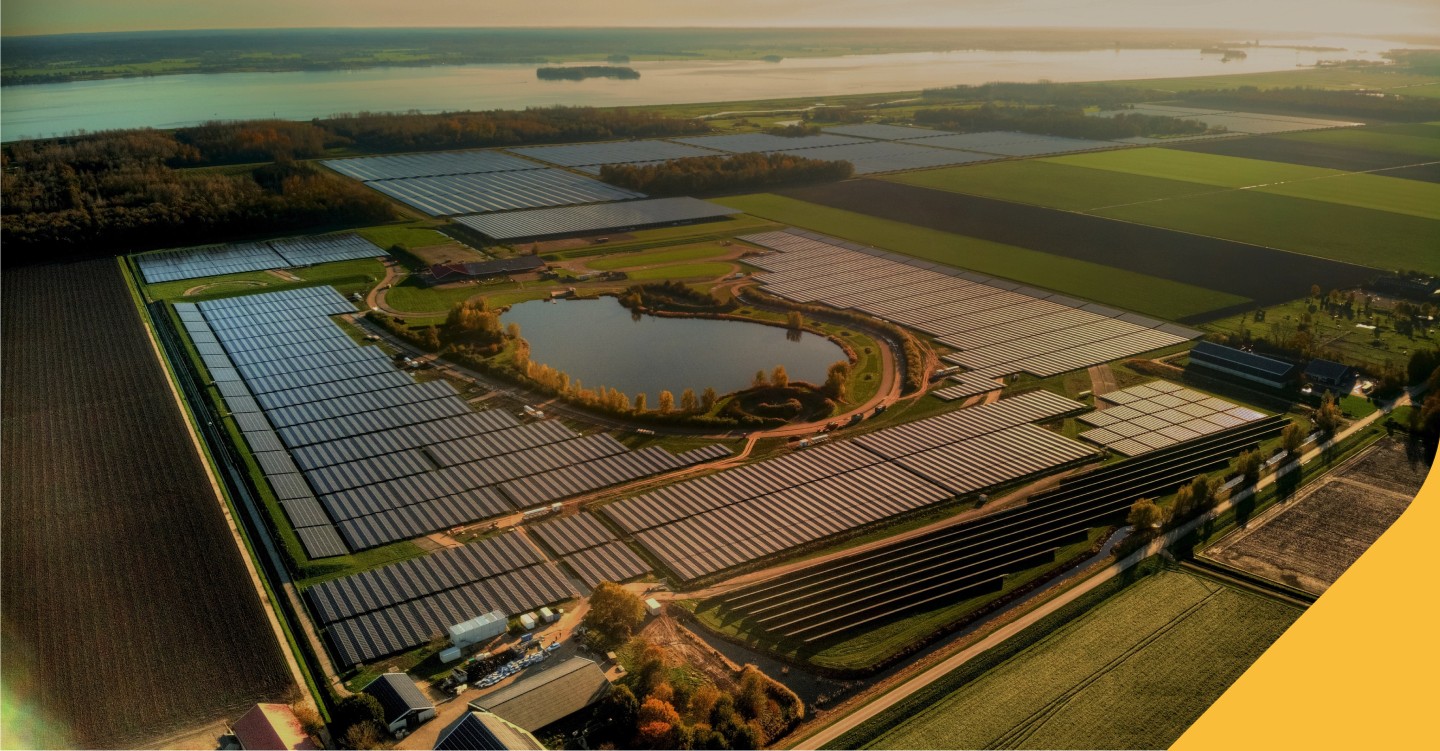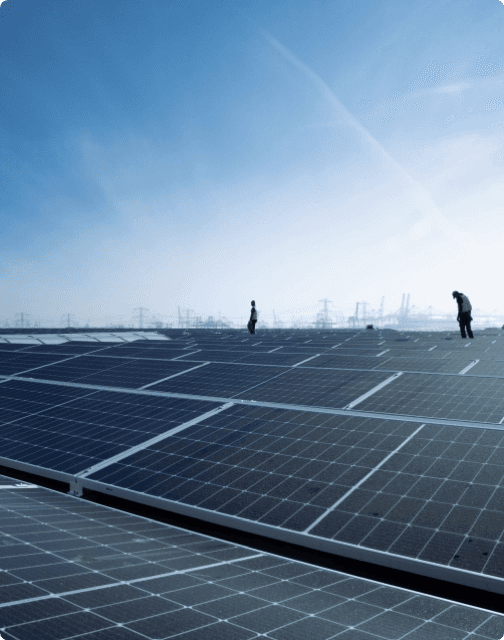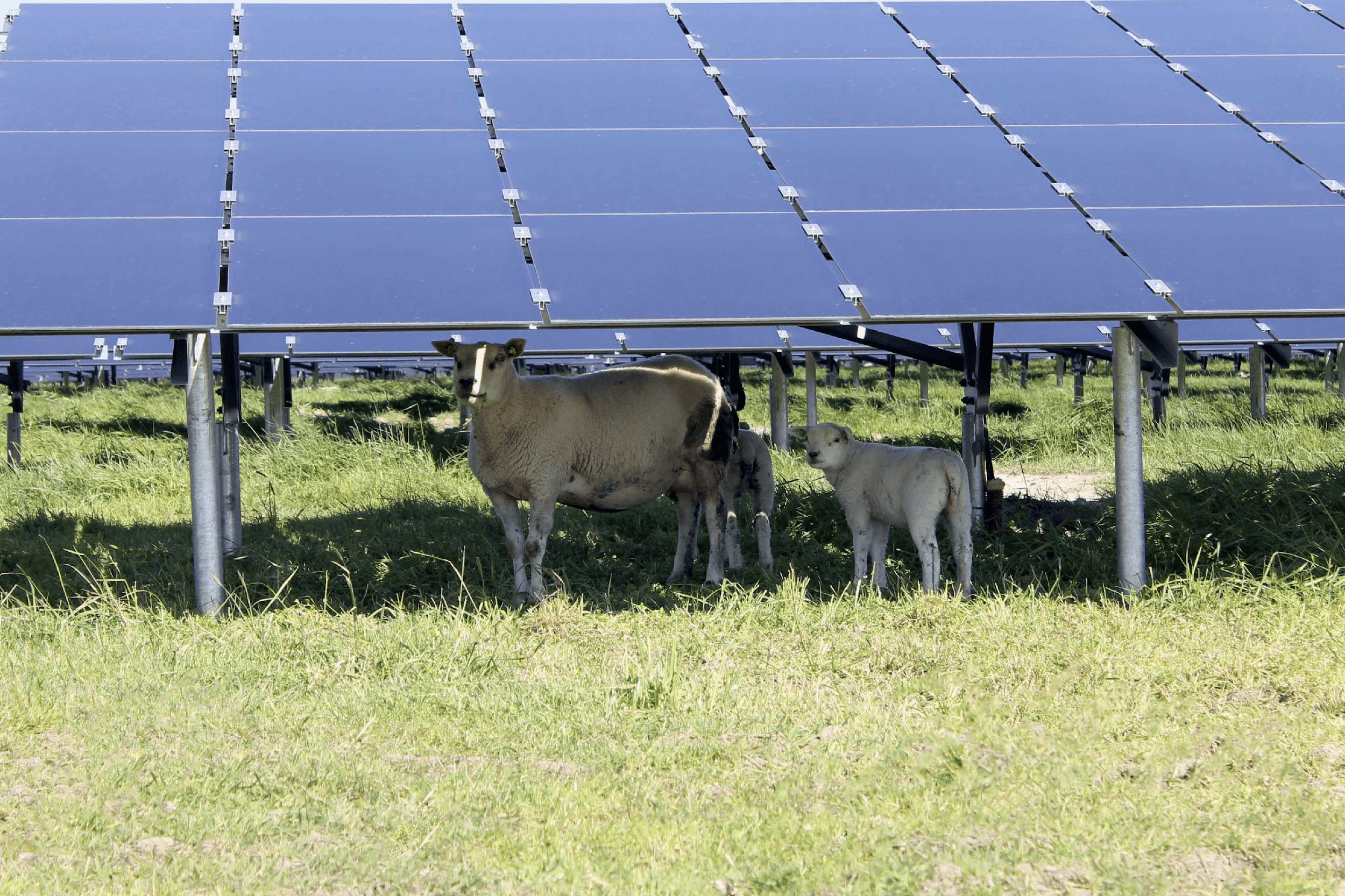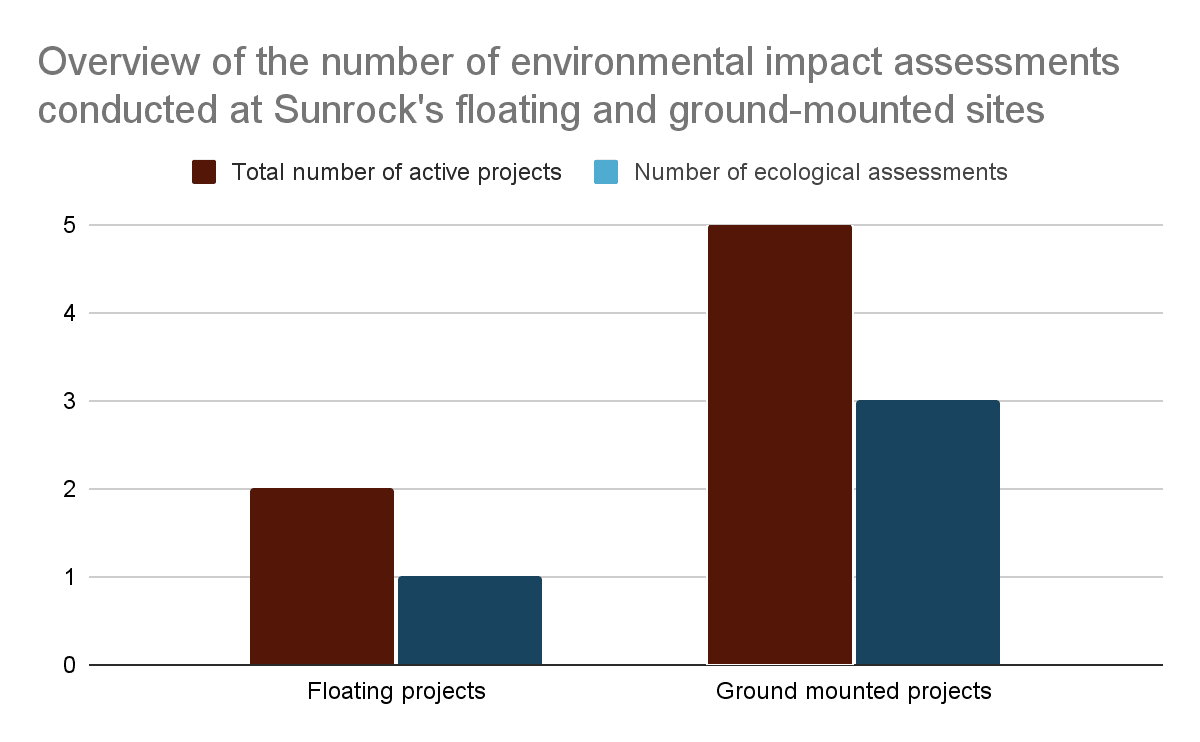
Reducing greenhouse gases while growing
Sunrock committed to the Science Based Target Initiative (SBTi) in 2021, through which we measure and take action to reduce our greenhouse gas (GHG) emissions.
Our commitment is to reduce our scopes 1 and 2 emissions (office & vehicles) by 50% by 2030 as compared to the baseline of 20 tCO₂ equivalent (tCO₂e) and to measure and reduce our scope 3 (operations & capital goods) emissions.
Sunrock’s dedicated internal ESG working group is responsible for collecting data, calculating and validating our emissions. They propose targets and policies to our management team for reaching the desired emissions reduction. This section contains the figures for 2022 and outlook to the future.
(c) Science Based Targets Initiative
Behind the numbers
Calculating 2022 emissions
We applied the emissions factor approach (consumption of energy in kWh equivalent x GHG emission factor = CO₂ equivalent emission in tons) from NL, Germany and UK government verified factors to calculate scope 1 & 2 and scope 3 direct control emissions. For scope 3 indirect control emissions we conducted Life Cycle Assessment following the ISO 14040/14044 methodological framework (for Standardization, 2006a,b). For background processes and inventory analysis we used the EcoInvent 3.8 cut-off database.

Kahya Engler
Technical Lead M&A and chairperson Sunrock ESG working group on Environment
Scopes explained
Scope 1 refers to emissions from company vehicles and from our office heating systems.
Scope 2 emissions are those resulting from the electricity purchased for our offices.
Scope 3 direct control is derived from employee business travel, commuting, energy related activities and office waste. Scope 3 indirect emissions mainly come from the capital goods used in our solar parks, such as the PV modules, inverters, cables and transformers.
2022
In 2022 we saw an increase in our scope 1 fuel combustion of 1.89 tCO₂e from our office heating systems.
We had an increase of 1.24 tCO₂e in company lease car emissions.
There were no emissions from purchased electricity as it comes from renewable sources.
Overall, our scope 1 & 2 emissions increased by 3.13 tCO₂e compared to 2021.
Sunrock’s direct control emissions of scope 3 increased by 27.74 tCO₂e.
Scope 3 indirect control increased by 6,422 tCO₂e, indicating that over 99% of our total emissions comes from capital goods, mainly PV modules.
Mission
Sunrock continues to grow its business in helping clients reduce the carbon footprint of their properties while taking steps to reduce our emissions in the process. We recognize that this is a joint effort with our office property owners, suppliers of capital goods and construction partners. It is however worth noting that PV systems have an energy payback time of approximately one year as confirmed by the Fraunhofer Institute for Solar Energy Systems in 2022.
Ready to reduce our emissions in the upcoming years
Carbon reduction efforts are part of Sunrock’s non-financial key performance indicators 2023. Data knowledge is crucial for emission reduction. As part of ISO 9001 we refined our data collection in 2022 and will further improve this in 2023.
Scope 1
We have signed a new HQ office lease with a heat-pump; we will be moving in mid 2023.
As of October 2022, pool cars were 100% electric, in 2023 they will be solely charged with electricity from renewable sources.
Scope 2
Install a PV system on our new HQ office.
All new office leases (outside HQ) use electricity from renewable energy sources.
Scope 3 – direct control
Encourage commuting by public transport and offer employees electric lease cars and E-bikes.
Display all greenhouse gas emissions data on internal monitoring screens to engage with employees on carbon reduction conversations.
Scope 3 – indirect control
Continue to engage in conversations with clients, suppliers and partners on electric transport solutions.
Use shorter transport routes and green electricity in manufacturing 2 PV systems with a lower carbon footprint in 2024.
Set longer term targets for scope 3.
Employee-driven approach to ESG
Thoughts of an ESG working group contributor
In what ways has being part of an ESG working group improved/affected your understanding of specific ESG topics?
Working with my colleagues on ESG topics at Sunrock has strengthened my understanding of the importance of sustainability in corporations in general but also how the topic is of growing importance to our supply chains and partners. On the one hand I see more and more partners are keen to work on their footprint to achieve the 1.5 °C climate target. On the other hand I realize how complicated and challenging it is to implement sustainable ideas, being in a cost conscious market, but I also see how many possibilities are available.
How has this influenced the way you perform your regular function, if any?
Working in the field of carbon has brought me closer to the life-cycle approach and how it can affect companies positively. It has positively influenced my way of working and thinking at Sunrock. I try to include aspects of sustainability and minimize negative effects on the environment in my daily activities.
What is your call to action for fellow Sunrockers with respect to the topic of ESG?
Sustainability should always be on our agenda. Of course, working in the field of renewable energy already gives us positive credits but to be truly sustainable we should also include life-cycle thinking, being aware of our environmental impacts (also thinking about biodiversity and resilience on climate change) in our daily businesses and also on a personal level by including a recycle, reuse and reduce mentality.
Julian Lorenz Kolodziey
Project-Manager and member of the Sunrock ESG working group on Environment
Everything works together and everything we do has an impact and affects our surroundings. "Biodiversity" stands for all the living organisms and species that work together to sustain life on Earth.
Goal
A minority of Sunrock’s projects is developed on land or water. We aim to avoid any negative impact on plant and animal life at these ground-mounted and floating sites and, where possible, to achieve a net positive effect on biodiversity.
Site selection and development
We develop our projects on land or water only in areas rezoned for solar energy, to ensure they aren't built in Natura 2000 zones. Potential sites for solar projects are often large degraded industrial sites or depleted farmland. Most of the time, they are proposed by the owners themselves. We start development of a PV facility after ecological assessments have been made and when all necessary RFP requirements are met.
Learning
We want to increase our understanding of the impact of our ground and floating projects on the creatures that inhabit the area. We actively ask for expert advice on responsibly integrating PV installations into the landscape.
Independent advice
Independent experts help us develop the project in a way that doesn't have a negative impact on biodiversity. They provide us with information about the plants and creatures in the vicinity of the projects and measures we can take to ensure their viability. In this way, we can make better decisions when managing the area and think of additional precautions to take to avoid disturbing the local flora and fauna.
Temporary and permanent measures
Each ecological assessment provides Sunrock with recommendations. Most refer to the implementation phase of our solar projects on land and/or water. In a few cases, the location of the project itself affects the habitat of specific species. Permanent mitigation measures based on legal obligations are then recommended.
Habitat for martens
The construction of a solar park within one plan area would have an impact on part of the habitat for small martens. This solar park was planned with the goal of preserving as much of the existing habitat as possible while also improving habitat and compensating for lost habitat. Based on ecological assessments we took mitigation measures, including the installation of two marten boxes to provide shelter for the polecat, weasel, and ermine as well.
2023 ambition
Sustaining and improving biodiversity is an important aspect of the environmental goals set for 2023. Therefore we adopt a sound strategy that supports this. In 2023, we aim to develop a strategic plan outlining opportunities to increase biodiversity in our parks, to make a lasting positive contribution to the environment.
Circular Solar Parks
More clean energy with less (raw) materials
Vision:
Sunrock aims to support the earth by looking at more sustainable approaches to resource use, and more sustainable management of the materials in the components in our PV-systems that have reached their end-of-life.
A truly clean energy future is one in which the regeneration of the earth and its natural resources moves at a higher pace than the extraction of primary materials.
Mission:
We want to use as few materials as possible, use them as long as possible, and bring 100% of them back into circulation at the end of the product life-time.
In doing so, we increase the ratio of kwh of clean energy generated by our solar parks, per gram of raw material extracted from the earth.
In other words: we want to produce more kwh of clean energy using less (virgin) materials.
Ultimately, we make sure that materials that have become obsolete do not end up on landfill or in a incinerator.
Our target is to have 0% of obsolete materials end up in incinerators or in landfills by 2050, 50% circularity in 2030
The circularity calendar of Sunrock’s working group
2022
Engage in dialogue with critical external stakeholders on the challenges and opportunities for a circular solar sector;
Formulate the vision of Sunrock on circularity, based on the context of our operations;
Action plan to calculate the ratio of renewable energy generated by gram material use by Sunrock;
Kick off data collection on the treatment of damaged components by Sunrock’s Operations and Maintenance partners.
2023
Baseline assessment of the ratio of clean energy generation per gram material use;
Use baseline to develop an action plan for the reduction of used materials together with Sunrock procurement, operations and asset management;
Explore partnerships with producers of PV-system components that contain recycled (and/or afterwards upcycled) materials.
Employee-driven approach to ESG
Thoughts of an ESG working group contributor
In what ways has being part of an ESG working group improved/affected your understanding of specific ESG topics?
Before joining the working group, I had only superficial knowledge of ESG topics. The willingness to learn more was one of the reasons I decided to join. Now I have substantially improved my understanding of ESG topics, especially the topic of carbon emissions, which I work closely on. My tasks are related to data collection and visualization, so I learned a lot about the structure of Sunrock's emissions and the complexity that is hidden behind published statistics. I know that this is just the beginning, and I'm looking forward to gaining more knowledge.
How has this influenced the way you perform in your regular function, if any?
Due to my engagement in ESG-related discussions, I now think more often about how different actions, even small ones, contribute to the environment. I have started to make more sustainable choices when it comes to food, transportation, or storing my data.
What is your call to action for fellow Sunrockers when it comes to ESG? What do you consider a critical ESG highlight for Sunrock for 2022?
I encourage everyone to have a look at our ESG goals and think of ways to achieve them (and then reach out to us). Besides that, I invite everyone to join ESG working groups and find their personal way of making a contribution. As concerns the critical highlight of 2022, for me it was the publishing of Sunrock Climate Disclosure on our website. I think it is an important milestone in our journey towards a cleaner future.
Daria Kolesnik
Business Intelligence Specialist and member of the Sunrock ESG working group on Environment

















